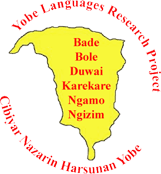The Yobe Languages Bibliography
 On this page you will find a collection of linguistic studies of individual Yobe State languages and of cross-linguistic studies that include two or more Yobe languages. Most items are by one or more members of the Yobe language research team, but some significant studies by others are included.
On this page you will find a collection of linguistic studies of individual Yobe State languages and of cross-linguistic studies that include two or more Yobe languages. Most items are by one or more members of the Yobe language research team, but some significant studies by others are included.
Click here to return to the main page of the Yobe Languages Research Project.
Cross-Linguistic Studies Involving Yobe State Languages
Russell G. Schuh. 2003. “A comparative study of West Chadic verb suffixes”. In Selected Comparative-Historical Afrasian Linguistic Sudies in Memory of Igor M. Diakonoff, M. Lionel Bender, Gabor Takacs, and David L. Appleyard (eds.), Lincom Europa, pp. 71-86. Paul Newman, in his Encyclopedic Grammar of Hausa (Chapter 76), has shown that many Hausa verbs have stem final consonants that are not part of the original root, and moreover that these “remnant affix” consonants comprise only a subset of the consonants of Hausa. Study of other West Chadic languages reveals that many verbs in those languages likewise not only have such affixes but also the subset of consonants in those affixes are essentially identical to those of Hausa.
Russell G. Schuh. 2008. “Finding cognates between Hausa and its Chadic cousins”. “Finding cognates in West Chadic.” In Gábor Takács (ed.), Semito-Hamitic Festschrift for A.B. Dolgopolsky and H. Jungraithmayr, pp. 272-283. Berlin: Dietrich Reimer. The paper shows that sound changes, derivational morphological processes, and semantic changes have obscured cognates across West Chadic languages and how “undoing” these processes allows one to identify even dissimilar words as cognates.
“Yobe State, Nigeria as a linguistic area”: (posted July 9, 2005) Research in the Yobe Languages Research Project has shown that in addtion to being genetic sisters/cousins, the indigenous Chadic languages of Yobe State comprise a linguistic area, that is, they share features that result from contact and bilingualism distinct from the features they share due to inheritance from their proto-West Chadic ancestral parent. More precisely, the languages around Potiskum (Bole, Ngamo, Karekare, Ngizim) form an area with its own particular features, the Bade area including Bade dialects and Duwai form an area with its features, and all the languages taken together have yet a separate set of shared areal features. This paper documents some of those features from lexicon, morphology, and syntax. A much abbreviated form of this paper was presented at the 31st Annual Meeting of the Berkeley Linguistics Society in February 2005.
“The Totality Extension and focus in West Chadic”: (Posted September 24, 2005) Paper presented at the International Berlin Focus Conference, 6-8 October 2005) A group of West Chadic languages spoken in the area of Potiskum, Yobe State, Nigeria, all have a verbal extension that has usually been called the “Totality Extension”, mainly because it is the form these languages use to translate Hausa “Grade 4”, a form that, in one of its main functions, indicates that an action has been done to its logical full extent. However, the distribution of the Yobe language totality extensions shares virtually no properties with Hausa Grade 4 nor with extensions in other languages with a “Grade 4-like” meaning. This paper argues, from a number of perspectives, that the Yobe totality extension is actually a marker of auxiliary focus in the sense of Hyman and Watters (1984). Develop of this morphologically marked function is an areal feature inasmuch as it is shared by languages that are not closely related to each other genetically, and more closely related by geographical remote languages do not have this property.

